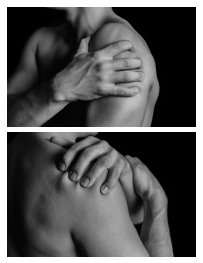Subacromial Decompression (Shoulder Surgery)
 A subacromial decompression is done to treat shoulder impingement syndrome also called subacromial impingement. Impingement can be very painful and occurs when the rotator cuff tendon gets pinched between the humeral head (ball of shoulder) and acromion (bone on top of shoulder). The rotator cuff is a common source of pain in the shoulder. When you raise your arm to the level of your shoulder the space narrows between the rotator cuff and undersurface of the acromion.
A subacromial decompression is done to treat shoulder impingement syndrome also called subacromial impingement. Impingement can be very painful and occurs when the rotator cuff tendon gets pinched between the humeral head (ball of shoulder) and acromion (bone on top of shoulder). The rotator cuff is a common source of pain in the shoulder. When you raise your arm to the level of your shoulder the space narrows between the rotator cuff and undersurface of the acromion.
The acromion can impinge or rub against the rotator cuff tendon and the subacromial bursa causing inflammation and pain. The bursa is a lubricating sac between the rotator cuff and acromion. Many patients that have shoulder impingement have inflammation of the rotator cuff (rotator cuff tendinitis) as well as inflammation of the bursa (subacromial bursitis).
Common Causes of Subacromial Impingement
The most common causes of subacromial impingement include repetitive activities, such as lifting, pulling, or pushing, and especially overhead activities. Symptoms commonly include pain at the front of the shoulder when the arm is raised and/or with reaching movements. There may also be pain as the arm is lowered from an elevated position. There may be tenderness and swelling in the front of your shoulder. If symptoms do not resolve with conservative treatment such as rest, oral anti-inflammatory medication, steroid injection, and/or physical therapy, then a subacromial decompression surgery is indicated.
A subacromial decompression surgery is done as an all-arthroscopic procedure (visualized using a camera and video monitor; performed using small surgical instruments through very small incisions). The undersurface of the acromion is smoothed out (acromioplasty) using a motorized burr and any inflamed, thickened bursa tissue is removed (bursectomy) using a motorized resector and an electrothermal wand. The rotator cuff tendon surface will be thoroughly inspected to assess for a rotator cuff tear.
Surgery is done under general anesthesia and as an outpatient procedure (you are able to go home the same day). There are always risks and benefits of surgery, and there are never any 100% guarantees regarding the outcome of surgery. The surgeon’s goal is to minimize the risks and help guide you to the best path of recovery. After surgery your arm will be immobilized in a sling as needed for support and comfort. Physical therapy is commonly prescribed after surgery to ensure the best recovery.